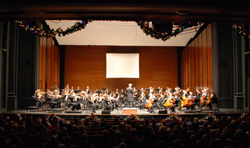 The Lyric Theatre was nearly full on December 19 as supporters of the Kauffman Center for the Performing Arts, the ArtsKC Fund of the Arts Council of Metropolitan Kansas City and the Kansas City Symphony gathered for a special Symphony performance. Music included pieces by Rimsky-Korsakov, Bach, Britten, Prokofiev and others. Both Music Director Michael Stern and Assistant Conductor Steven Jarvi took to the podium at different times during the evening, providing a wonderful sampler of music and conducting for the enthusiastic audience.
The Lyric Theatre was nearly full on December 19 as supporters of the Kauffman Center for the Performing Arts, the ArtsKC Fund of the Arts Council of Metropolitan Kansas City and the Kansas City Symphony gathered for a special Symphony performance. Music included pieces by Rimsky-Korsakov, Bach, Britten, Prokofiev and others. Both Music Director Michael Stern and Assistant Conductor Steven Jarvi took to the podium at different times during the evening, providing a wonderful sampler of music and conducting for the enthusiastic audience.
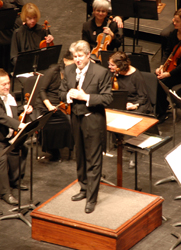 The musical evening was punctuated with comments from Michael Stern, who shared his excitement about being part of Kansas City’s arts community at this particular time in history. He acknowledged that the Symphony has reached new heights just as Kansas City builds a world-class performance space, two things that create a dynamic combination for future musical performances. He thanked Julia Irene Kauffman for her vision and perseverance in making the Kauffman Center for the Performing Arts a reality. And, given the incredible attention being paid to acoustics in the new concert hall, Stern promised the supportive audience that they have a great deal to look forward to.
The musical evening was punctuated with comments from Michael Stern, who shared his excitement about being part of Kansas City’s arts community at this particular time in history. He acknowledged that the Symphony has reached new heights just as Kansas City builds a world-class performance space, two things that create a dynamic combination for future musical performances. He thanked Julia Irene Kauffman for her vision and perseverance in making the Kauffman Center for the Performing Arts a reality. And, given the incredible attention being paid to acoustics in the new concert hall, Stern promised the supportive audience that they have a great deal to look forward to.
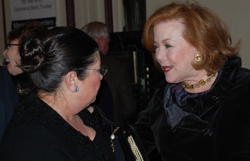 Guests, including Kauffman Center board member Shirley Helzberg and donor Myra Siegel, enjoyed champagne and conversation at intermission.
Guests, including Kauffman Center board member Shirley Helzberg and donor Myra Siegel, enjoyed champagne and conversation at intermission.
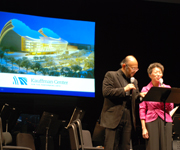 After intermission Jane Chu, President and CEO of the Kauffman Center, joined Yasu Toyota, the Kauffman Center’s acoustician and key design team member, on stage for a special presentation. They shared insights into the thinking and design details that are going into the acoustical planning for the concert hall. Toyota, who has designed performances spaces all around the world, talked about how the hall is configured to provide both intimacy and spacial volume needed for excellent, non-amplified sound. Jane Chu explained how a one-tenth scale acoustical model was used to test the concert hall design and avoid problems when construction is done at scale.
After intermission Jane Chu, President and CEO of the Kauffman Center, joined Yasu Toyota, the Kauffman Center’s acoustician and key design team member, on stage for a special presentation. They shared insights into the thinking and design details that are going into the acoustical planning for the concert hall. Toyota, who has designed performances spaces all around the world, talked about how the hall is configured to provide both intimacy and spacial volume needed for excellent, non-amplified sound. Jane Chu explained how a one-tenth scale acoustical model was used to test the concert hall design and avoid problems when construction is done at scale.
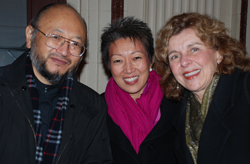 After the concert, Yasu Toyota posed with Jane Chu and Joan Israelite, retiring executive director of the Arts Council of Metropolitan Kansas City. The Arts Council was one of the partners in this special concert held to thank donors and supporters who make the performing arts in Kansas City strong and vibrant.
After the concert, Yasu Toyota posed with Jane Chu and Joan Israelite, retiring executive director of the Arts Council of Metropolitan Kansas City. The Arts Council was one of the partners in this special concert held to thank donors and supporters who make the performing arts in Kansas City strong and vibrant.
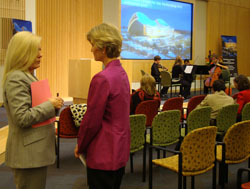 Kauffman Center Holds Ambassador Celebration
Kauffman Center Holds Ambassador Celebration
More than 150 people participated in the Kauffman Center Ambassadors’ celebration on October 22, 2008. The event, which recognized their relaunch as a self-sustaining group, was held at the Kauffman Foundation Conference Center and included a presentation — and sincere thank you — from Julia Irene Kauffman, president of the Kauffman Center Board of Directors. Julia is pictured to the left, along with Ambassador President-Elect Anne Peterson.
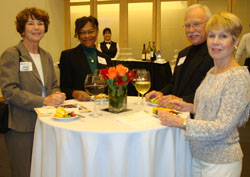 Ambassadors enjoyed a reception and met others interested in becoming members. The reception was followed by the short program that included an update on construction progress made by Jane Chu, president and CEO of the Kauffman Center and Ken Dworak, owner’s representative. Lisa Shubert Hickok, president of the Ambassadors, also addressed the group and explained the newly-formed membership structure.
Ambassadors enjoyed a reception and met others interested in becoming members. The reception was followed by the short program that included an update on construction progress made by Jane Chu, president and CEO of the Kauffman Center and Ken Dworak, owner’s representative. Lisa Shubert Hickok, president of the Ambassadors, also addressed the group and explained the newly-formed membership structure.
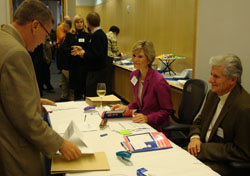 Participants had the chance to sign up for a variety of volunteer activities and events being planned by this energetic membership group. Ambassadors Anne Peterson (to the left in the purple jacket) and David Renner visit with a person interested in joining the group.
Participants had the chance to sign up for a variety of volunteer activities and events being planned by this energetic membership group. Ambassadors Anne Peterson (to the left in the purple jacket) and David Renner visit with a person interested in joining the group.
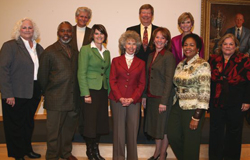 The volunteer group called Kauffman Center Ambassadors is hardly a new concept. For more than two years, they have been all over town — literally — telling the Kauffman Center story to any interested party. Now they’ve reorganized as a membership organization that is self-sustaining and has a self-governing board of directors (pictured to the right). Board members shown: (from the left, front row): Kathy Peterson, Gary Maltbia, Nicolle Ratliff, Marilyn Salomon, Lisa Hickok, Anita Maltbia, Cheryl Spear. Back row: David Renner, Dick Fagerberg and Anne Peterson.
The volunteer group called Kauffman Center Ambassadors is hardly a new concept. For more than two years, they have been all over town — literally — telling the Kauffman Center story to any interested party. Now they’ve reorganized as a membership organization that is self-sustaining and has a self-governing board of directors (pictured to the right). Board members shown: (from the left, front row): Kathy Peterson, Gary Maltbia, Nicolle Ratliff, Marilyn Salomon, Lisa Hickok, Anita Maltbia, Cheryl Spear. Back row: David Renner, Dick Fagerberg and Anne Peterson.
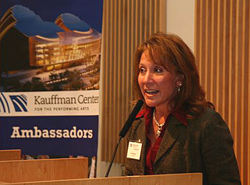 “We saw that the Ambassadors had the core of a membership organization that could have long-term impact for the Kauffman Center,” explains Lisa Hickok, pictured at the left, and who has been tapped as president of the new organization “As a self-sustaining, self-governing group, Ambassadors can take on roles beyond that of cheerleader and move into program support and fund raising. But we’ll remain boosters at our core.”
“We saw that the Ambassadors had the core of a membership organization that could have long-term impact for the Kauffman Center,” explains Lisa Hickok, pictured at the left, and who has been tapped as president of the new organization “As a self-sustaining, self-governing group, Ambassadors can take on roles beyond that of cheerleader and move into program support and fund raising. But we’ll remain boosters at our core.”
If you are interested in joining the Ambassadors, there is detailed information about membership categories, responsibilities and how to join on the Kauffman Center website.
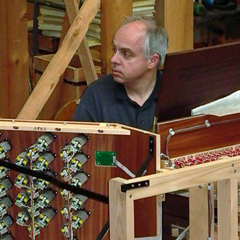
Concert Hall Organ Takes Shape in Montreal
How many architects, designers, organ consultants, builders, installers and semi-trailers does it take to put an exceptional organ inside the Kauffman Center concert hall?
There’s no underlying joke here. Creating our concert hall organ is a gigantic project that will take two years of intense work. “At the end, it will arrive at the hall as a big puzzle ready to be carefully assembled and tonally finished to be in consonance with the acoustic space,” says Jacquelin Rochette, tonal director with organ builder Casavant Frères in Montreal.
Our conversation with Rochette outlines the organ design and building process, already well underway.
Where does one begin to create a grand concert hall organ like ours?
 Rochette This multi-phase process will take two years and is intensely collaborative. The first steps involve Casavant working with the Kauffman Center to define the various specifications for the organ, going from the organ disposition and choice of action to selection of the various voices. And we take into account the various requirements such as blower room, air intake, temperature and humidity control plus mechanical and electrical requirements.
Rochette This multi-phase process will take two years and is intensely collaborative. The first steps involve Casavant working with the Kauffman Center to define the various specifications for the organ, going from the organ disposition and choice of action to selection of the various voices. And we take into account the various requirements such as blower room, air intake, temperature and humidity control plus mechanical and electrical requirements.
We are working with acoustical consultant Yasu Toyota, and organ consultant James David Christie, two experts who are great leaders in their fields and are recognized all around the world for their knowledge and experience. As a result of this part of the process, we create and sign off on what we call the “specification of the instrument.”
Concert Hall Organ Takes Shape in Montreal
Once we’ve reached that point, we are able to develop drawings of the interior of the instrument and of all the components. This includes the chests, the wooden boxes containing all the mechanisms that will enable the organist to play the instrument. Also the mechanical action and its hundred of feet of wooden linkages, the pipes, the stop action and other controls at the disposition of the organist. These “ensemble drawings” have been completed for months, and we are currently completing all the detailed drawings and making final choices to insure the most responsive “key action” or “key touch.”
How does the Casavant team interact with architect Moshe Safdie?
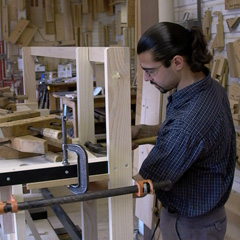 We have already established with Moshe the location of the organ departments (five divisions on four keyboards and pedalboard) and various pipes. It is an honor for us to work with an architect the caliber of Moshe Safdie. A member of our team and colleague, designer Didier Grassin, is working closely with Moshe to create the visual design of the organ in the hall. We want the parts of the organ that the audience sees to reflect Safdie’s vision for the hall and is compatible to the organ mechanisms, to its use and functions, and to its tonal concept. This process is very collaborative and is still unfolding, so I can’t share any details. We do know, however, that Safdie will be using some of the wooden pipes of the instrument to develop a visual texture that will contrast with the interior design.
We have already established with Moshe the location of the organ departments (five divisions on four keyboards and pedalboard) and various pipes. It is an honor for us to work with an architect the caliber of Moshe Safdie. A member of our team and colleague, designer Didier Grassin, is working closely with Moshe to create the visual design of the organ in the hall. We want the parts of the organ that the audience sees to reflect Safdie’s vision for the hall and is compatible to the organ mechanisms, to its use and functions, and to its tonal concept. This process is very collaborative and is still unfolding, so I can’t share any details. We do know, however, that Safdie will be using some of the wooden pipes of the instrument to develop a visual texture that will contrast with the interior design.
Note: The Concert Hall organ will have 5,548 pipes and 79 stops. Just about 10% of the pipes will actually be visible to concert-goers.
When will Casavant Frères actually begin to build the organ?
We have already begun the construction of the organ components. Since the ensemble drawings are well advanced, the  worksheets for the pipework have been in the shop for a few months and the pipes are gradually taking shape. We will be very busy in the coming year while we pour the various alloys of tin and lead, prepare the metal sheets of various thickness, and then build the pipes. At the same time, we will be building the organ structure, three large expressive wooden enclosures with shutters to control the volume of specific organ departments, the chestwork which contains the organ mechanisms, and so on. We will also build the keyboards and pedalboard of the attached console, and all the wooden levers, squares, linkages, forming the organ mechanical action which will provide to organists a full control of all the tonal nuances of the instrument.
worksheets for the pipework have been in the shop for a few months and the pipes are gradually taking shape. We will be very busy in the coming year while we pour the various alloys of tin and lead, prepare the metal sheets of various thickness, and then build the pipes. At the same time, we will be building the organ structure, three large expressive wooden enclosures with shutters to control the volume of specific organ departments, the chestwork which contains the organ mechanisms, and so on. We will also build the keyboards and pedalboard of the attached console, and all the wooden levers, squares, linkages, forming the organ mechanical action which will provide to organists a full control of all the tonal nuances of the instrument.
Note: See the Casavant workshop and learn more about the art of organ building.
How do you assure that the components will work together well?
Our team actually assembles the entire organ inside our workshop, making it fully playable, and runs tests for functioning, trying all voices and sound ensembles, and full power, checking the wind capacity and stability, making sure that all controls work properly and that the entire instrument is fully reliable. At this point in the process, Kauffman Center representatives and consultants will be invited to visit our shop to hear and play the instrument.
Once complete, how does the organ get from Montreal to Kansas City?
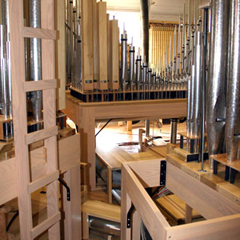 After testing is finished, we disassemble the entire organ and carefully identify and wrap each component for shipping. The organ will probably fill three semi-trailer trucks for its trip to Kansas City. Four members of our team will spend two months on site in Kansas City installing the organ. They will call on some additional local help to raise heavy components to their location. It’s a gigantic construction that will take up to eight weeks to complete and adjust to a very high precision, much like a clock. But even then we’re still not finished.
After testing is finished, we disassemble the entire organ and carefully identify and wrap each component for shipping. The organ will probably fill three semi-trailer trucks for its trip to Kansas City. Four members of our team will spend two months on site in Kansas City installing the organ. They will call on some additional local help to raise heavy components to their location. It’s a gigantic construction that will take up to eight weeks to complete and adjust to a very high precision, much like a clock. But even then we’re still not finished.
We will then tonally finish the instrument: establishing and refining internal tonal balances while making the organ “fit” with the hall’s acoustics and fullfilling the musical needs of the orchestra. I’ll be on site to supervise the tonal finishing of the instrument. Namely, this is to provide the generous sound and power that an orchestra will require, while the organ is used as a solo instrument with the orchestra, or being part of the orchestra, playing sometimes an accompanimental role, or simply crowning the orchestra in large ensembles. During that period, the organ will be played with the Symphony as part of the voicing process.
And then it’s ready for us to enjoy?
Then we hope that the instrument will be used regularly, in various concert presentations with and without the Symphony, and that it will be accessible to other musicians as well. We hope that the instrument will be an inspiration to musicians and to composers, and that it will be a very fine, grand instrument that will engage and delight the many generations to come. We are sparing no efforts to accomplish this.
Read another story about the concert hall organ.
It may have been the time Susan Susz’s parents took her and her three siblings to Starlight to see “Sound of Music.” Or it perhaps it was her mother’s penchant for singing opera around the house — and at friends’ weddings. Or it might have been the piano lessons she took as a child. Whatever the influence, Susan Susz has become an enthusiastic arts supporter. And that commitment led to Susan and her husband Mark become donors to the Kauffman Center.
“When Mark and I married 12 years ago,” Susan shared recently, “I started engaging him in the arts activities I enjoyed. Soon, attending the theater, ballet and the symphony became activities we enjoyed regularly together.” Susan quickly added that Mark didn’t require much convincing; business interests earlier in his life just took most of his attention. Now that he’s sold his business and retired, the arts fit right in.
Mark and Susan Susz’s introduction to the Kauffman Center came through good friends Tom and Linda Beal. “We had heard bits and pieces about a new performing arts center, but no one had really filled us in,” Susan recalls.
That issue was remedied when the Beals invited them to lunch with Julia Irene Kauffman along with a small group of potential supporters. “We were immediately impressed,” Susan shared. Mark and Susan liked the idea of Kansas City getting high-quality performance spaces for the groups they enjoyed. “Plus we were wowed by the emphasis on quality. There was so much attention being placed on acoustics and technical excellence,” Susan added.
Later, Mark and Susan met with President & CEO Jane Chu and began to talk about a contribution to the center. After reviewing a range of naming opportunities available to donors, Mark and Susan decided to fund and name three items within the Kauffman Center, including a glass elevator that is set prominently in the grand gallery.
“I liked the centrality of this special elevator and its graceful design,” Mark said. “Funding the elevator also seemed to have a nice synergy with our personal interest in getting more people to arts performances.” Susan says that the location of the Kauffman Center is so prominent that people will easily find their way from the highway loop to the center. “Then the elevator will whisk them away to a delightful experience. I’m looking forward to everything about it,” she concludes.
Get more information about naming opportunities.
More than 150 people attended a Kauffman Center event on June 30 hosted by Ambassadors Anita and Gary Maltbia at a new midtown art gallery. “We are both truly excited about the potential of the Kauffman Center,” says former assistant city manager Anita Maltbia. “By hosting an event at the new Frazier Art Gallery, Gary and I managed to combine several interests and passions — and throw a really fun party at the same time.”
When the Maltbia’s told their friend, Bob Frazier, about their idea to host an event, he immediately offered to let them use the new Frazier Art Gallery at 3120 Troost. They assembled a list of friends, colleagues, family and business partners. They also featured as entertainment for the event, “The Kansas City Youth Jazz Band.” “At the Kansas City Young Audiences auction last fall Anita and I won the bid on a performance of the band. It made perfect sense to call on them and the venerable Leon Brady, director of the group, to perform at this event for the Kauffman Center,” says Gary Maltbia.
Jane Chu, president and CEO of the Kauffman Center was impressed by the Maltbia’s detailed planning — and thrilled by their obvious commitment to the new performing arts center. “We were all pleased by the turnout and really enjoyed getting to know the Maltbia’s diverse friends and family.” During a short program Anita and Gary talked about why they have become such active boosters of the Kauffman Center. Chu made a short presentation and invited guests to get involved. At several points in the evening, the 22 high school students from throughout the metropolitan area showed off their musical talents through several jazz numbers. “We can’t wait to have young people like this engaged at the Kauffman Center,” Chu commented.
A new five-minute video about the Kauffman Center, developed by Elaine Hamilton of Vision Teleproduction, Inc., was also unveiled that evening. “In this short video I focused on the Kauffman Center’s potential to energize our overall arts experiences and also emphasized the center’s commitment to youth — right in keeping with the jazz band that played that evening,” shared Hamilton, producer of the video. “I also wanted to show how central the Kauffman Center is to Kansas City’s exciting downtown revival.”
Guests also were able to enjoy the Frazier Art Gallery’s third art exhibit since opening last December. Works by local artists Reilly Hoffman and Trish Breed were on display throughout the gallery. Breed, who graduated 10 years ago from the Kansas City Art Institute, creates abstract oil paintings and multimedia pieces. Hoffman is a sculptor who won this year’s A. Zahner sculpture competition, bringing recognition to his work and generating scholarship income for the Art Institute.
The Frazier Art Gallery is the brainchild of businessman Robert Frazier, who owns the building. Jack Barkley, an architectural consultant and illustrator (most recently from New York), is gallery director. The Frazier is open from 11 a.m.-4:30 p.m. Tuesday-Saturday or by appointment.
To see the complete web photo album of the evening’s activities and guests, click here.
Want to see the one-tenth scale model? It’s available for group tours and individual visits by appointment. Call 816-994-7200 to arrange a tour.
See the latest rendering of the Kauffman Center’s Concert Hall.